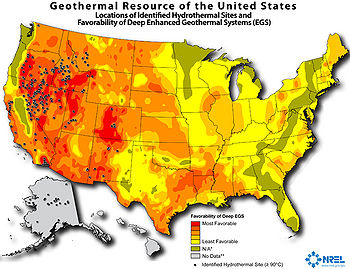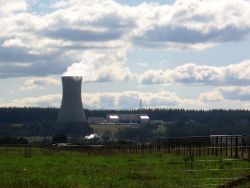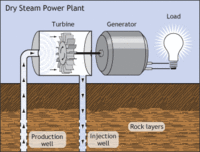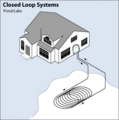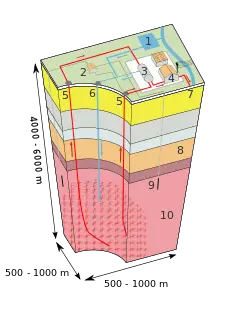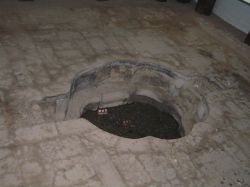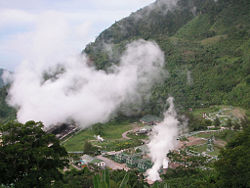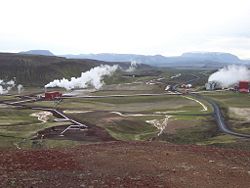| Renewable energy |
|---|
|
| Alternative energy |
In general terms, geothermal energy is thermal energy (the energy that determines the temperature of matter) generated and stored in the Earth. The geothermal energy of the Earth's crust originates from the original formation of the planet and from radioactive decay of minerals, resulting in continual production of geothermal energy below the earth's surface. The geothermal gradient, which is the difference in temperature between the core of the planet and its surface, drives a continuous conduction of thermal energy in the form of heat from the core to the surface.
In terms of alternative energy, geothermal energy is the energy that is harnessed from the Earth's internal heat and used for practical purposes, such as heating buildings or generating electricity. It also refers to the technology for converting geothermal energy into useable energy. The term geothermal power is used synonymously as the conversion of the Earth's internal heat into a useful form of energy, or more specifically as the generation of electricity from this thermal energy (geothermal electricity).
The four basic means for capturing geothermal energy for practical use are geothermal power plants (dry steam, flash steam, binary cycle), geothermal heat pumps, direct use, and enhanced geothermal systems.
Geothermal provides a huge, reliable, renewable resource, unaffected by changing weather conditions. It reduces reliance on fossil fuels and their inherent price unpredictability, and when managed with sensitivity to the site capacity, it is sustainable. Furthermore, technological advances have dramatically expanded the range and size of viable resources.

However, geothermal also faces challenges in the need for significant capital investment, and a significant amount of time in terms of building geothermal plants. There are limitations in terms of placement of geothermal plants in regions with accessible deposits of high temperature ground water, and construction of power plants can adversely affect land stability. Geothermal power plants also can lead to undesirable emissions, with power plant emitting low levels of carbon dioxide, nitric oxide, sulfur, methane, and hot water from geothermal sources may hold in solution trace amount of toxic elements, such as mercury, boron, and arsenic.
Earth's geothermal resources
The Earth's geothermal energy comes from the heat from the original formation of the planet (about 20 percent) and from the thermal energy continually generated by the radioactive decay of minerals (80 percent).[1] The major heat-producing isotopes in Earth are potassium-40, uranium-238, uranium-235, and thorium-232.[2]
The Earth's internal thermal energy flows to the surface by conduction at a rate of 44.2 terawatts (TW),[3] and is replenished by radioactive decay of minerals at a rate of 30Â TW.[4] These power rates are more than double humanityâs current energy consumption from all primary sources, but most of this energy flow is not recoverable. In addition to the internal heat flows, the top layer of the surface to a depth of 10Â meters (33Â ft) is heated by solar energy during the summer, and releases that energy and cools during the winter.
Outside of the seasonal variations, the geothermal gradient of temperatures through the crust is 25â30 °C (77â86 °F) per kilometer of depth in most of the world. The conductive heat flux averages 0.1 MW/km2. These values are much higher near tectonic plate boundaries where the crust is thinner. They may be further augmented by fluid circulation, either through magma conduits, hot springs, hydrothermal circulation or a combination of these.
Geothermal energy is considered "sustainable energy" and a "renewable energy resource" because the thermal energy is constantly replenished and the extraction by people is small relative to total content.[4] Although the planet is slowly cooling, human extraction taps a minute fraction of the natural outflow, often without accelerating it.
The Earth's geothermal resources are theoretically more than adequate to supply humanity's energy needs, but only a very small fraction may be profitably exploited. Estimates of exploitable worldwide geothermal energy resources vary considerably. According to a 1999 study, it was thought that this might amount to between 65 and 138Â GW of electrical generation capacity "using enhanced technology."[5] This study did not assess the potential with significantly new technologies.[5] Other estimates range from 35 to 2000 GW of electrical generation capacity, with a further potential for 140 EJ/year of direct use.[6]
If heat recovered by ground source heat pumps is included, the non-electric generating capacity of geothermal energy is estimated at more than 100 GW (gigawatts of thermal power) and is used commercially in over 70 countries. A 2006 report by MIT that took into account the use of Enhanced Geothermal Systems (EGS) concluded that it would be affordable to generate 100Â GWe (gigawatts of electricity) or more by 2050, just in the United States, for a maximum investment of 1 billion US dollars in research and development over 15 years.[7] The MIT report calculated the world's total EGS resources to be over 13Â YJ, of which over 200Â ZJ would be extractable, with the potential to increase this to over 2Â YJ with technology improvementsâsufficient to provide all the world's energy needs for several millennia.The total heat content of the Earth is 13,000,000 YJ.[6]
Within about 10,000 meters (33,000 feet) of the Earth's surface there is considered to be about 50,000 times the amount of energy in geothermal energy resources as in all the world's oil and natural gas resources.
The world's biggest geothermal energy resources are in China; the second-largest ones in Hungary. By taking account of its size (about the size area of Illinois), Hungary has the richest such resources per sq mile/km. The world's biggest producer of electricity from geothermal sources is the Philippines. Other important countries are Nicaragua, Iceland, New Zealand.
The adjective geothermal originates from the Greek roots γη (ge), meaning earth, and ΞΔÏÎŒÎżÏ (thermos), meaning hot.
Production
Geothermal energy/power is produced by tapping into the thermal energy created and stored within the earth. The four basic categories for capturing geothermal energy for practical use are:
- Geothermal power plants (dry steam, flash steam, binary cycle)
- Geothermal heat pumps
- Direct use
- Enhanced geothermal systems
Geothermal energy is used commercially in over 70 countries.[7] In 2004, 200 petajoules (56 TWh) of electricity was generated from geothermal resources, and an additional 270 petajoules (75 TWh) of geothermal energy was used directly, mostly for space heating. In 2007, the world had a global capacity for 10 GW of electricity generation and an additional 28 GW of direct heating, including extraction by geothermal heat pumps.[6] Heat pumps are small and widely distributed, so estimates of their total capacity are uncertain and range up to 100 GW.[7]
Estimates of the potential for electricity generation from geothermal energy vary sixfold, from .035 to 2TW depending on the scale of investments.[6] Upper estimates of geothermal resources assume enhanced geothermal wells as deep as 10Â kilometers (6Â mi), whereas existing geothermal wells are rarely more than 3Â kilometers (2Â mi) deep.[6] Wells of this depth are now common in the petroleum industry.
In the United States, according to the Geothermal Energy Association's 2013 Annual GEA Industry Update, total installed U.S. geothermal capacity was estimated at 3,386 MW and the installed geothermal capacity grew by 5%, or 147.05 MW, since the previous annual survey in March 2012.[8] This report noted that geothermal power plants were operating in eight states (Alaska, California, Hawaii, Idaho, Nevada, Oregon, Utah and Wyoming), and geothermal development was taking place in 6 more (Arizona, Colorado, North Dakota, New Mexico, Texas and Washington).[8]
In the United States, as noted above, most geothermal power plants are located in the western states.[9] California produces the most electricity from geothermal,[9] with installed capacity estimated to 2,732.2 MW in 2012, while the USAâs second leading geothermal state, Nevada, reached 517.5 MW.[8] There are a number of geothermal plants concentrated in south central California, on the southeast side of the Salton Sea, near the cities of Niland and Calipatria, California. The Basin and Range geologic province in Nevada, southeastern Oregon, southwestern Idaho, Arizona, and western Utah is now an area of rapid geothermal development.
The type of source impacts which method can be used for capturing geothermal energy for production of electricity or other practical use. Flash plants are the most common way to generate electricity from liquid-dominated reservoirs (LDRs). LDRs are more common with temperatures greater than 200 °C (392 °F) and are found near young volcanoes surrounding the Pacific Ocean and in rift zones and hot spots. Pumps are generally not required, powered instead when the water turns to steam. Lower temperature LDRs (120-200 C) require pumping. They are common in extensional terrains, where heating takes place via deep circulation along faults, such as in the Western United States and Turkey. Lower temperature sources produce the energy equivalent of 100M BBL per year. Sources with temperatures from 30-150 C are used without conversion to electricity for such purposes as district heating, greenhouses, fisheries, mineral recovery, industrial process heating, and bathing. in 75 countries. Heat pumps extract energy from shallow sources at 10-20 C for use in space heating and cooling. Home heating is the fastest-growing means of exploiting geothermal energy, with global annual growth rate of 30 percent in 2005,[10] and 20 percent in 2012.[11]
Heating is cost-effective at many more sites than electricity generation. At natural hot springs or geysers, water can be piped directly into radiators. In hot, dry ground, earth tubes or downhole heat exchangers can collect the heat. However, even in areas where the ground is colder than room temperature, heat can often be extracted with a geothermal heat pump more cost-effectively and cleanly than by conventional furnaces. These devices draw on much shallower and colder resources than traditional geothermal techniques. They frequently combine functions, including air conditioning, seasonal thermal energy storage, solar energy collection, and electric heating. Heat pumps can be used for space heating essentially anywhere.
Power plants
Geothermal power plants use the heat from deep inside the Earth to pump hot water or hot steam to the surface to power generators. Such power plants drill their own wells into the rock to effectively capture the hot water or steam.
Such plants often are placed in places with plenty of geysers, active or geologically young volcanoes, or natural hot springs because these are areas where the Earth is particularly hot a reasonable distance from the surface. The water in such regions also can be more than 200°C (430°F) just below the surface.
There are three different designs for geothermal power plants: dry steam, flash steam, and binary cycle. These all bring hot water or steam from the ground, use it to power generators, and then the condensed steam and remaining geothermal fluid is injected back into the ground to pick up more heat and prolong the heat source. The design selected for generating power from geothermal energy depends on the temperature, depth, and quality of the water and steam in the area. If the hot water is high enough in temperature, flash system can be used. If it comes out as steam, it can be used directly to power the turbine with the dry stream design. If it is not high enough in temperature, then the binary cycle can be used to pass the water through a heat exchanger to heat up a second liquid that boils at a lower temperature than water and can be converted to steam to power the turbine.
Dry steam
A dry stream power plant uses hot steam, typically above 235°C (455°F), to directly power its turbines. This is the oldest type of power plant and is still in use today. It is the simplest design in that steam goes directly through the turbine to power the generators, then is condensed into water in a cooling tower/condenser, and then returned to the ground.
The largest dry steam field in the world is The Geysers, 72 miles (116 km) north of San Francisco. The area was well known for hot springs, but actually does not have geysers, and the heat used is steam, not hot water. The Geysers began in 1960 and by 1990 had 26 power plants built in the area with a capacity of more than 2000 MW. However, the steam resource has been declining since 1988, due to the technology used and the rapid development of the area. The Geysers still had a net operating capacity of 725 MW by 2009 and the rocks underground remain hot.
Flash steam
Flash steam power plants use hot water above 182°C (360°F) from geothermal reservoirs and has the addition of a flash tank over the dry steam design. As the water is pumped from the reservoir to the power plant, the drop in pressure in the flash tank causes the water to vaporize into steam (depressurized or "flashed" into steam), which then flows past the turbine, powering the electric generators. Any water not flashed into steam is injected back into the reservoir for reuse, as is the water that is captured from the steam after it has moved the turbines.
As noted above, flash steam plants are the most common way to generate electricity from liquid-dominated reservoirs (LDRs), which are often found near young volcanoes surrounding the Pacific Ocean and in rift zones and hot spots.
Binary cycle
The third design, the binary cycle system or binary system, adds a heat exchanger as part of the design, in order to use hot water that is cooler than that of the flash steam plants. The hot fluid from geothermal reservoirs is passed through a heat exchanger, which transfers heat to a separate pipe containing fluids with a much lower boiling point, and thus more easily converted to steam. These fluids, usually Isobutane or Isopentane, running through a closed loop, are vaporized to produce the steam to power the turbine. The water from the ground is only used to transfer its heat to the second fluid and is returned to the ground.
The advantage to binary cycle power plants is their lower cost and increased efficiency. These plants also do not emit any excess gas and are able to utilize lower temperature reservoirs, which are much more common. Most geothermal power plants planned for construction are binary cycle.
Heat Pumps
A geothermal heat pump (GHP) can be used to extract heat from the ground to provide heat and cooling for buildings. Geothermal heat pumps are also known as ground-source heat pumps, GeoExchange heat pumps, earth-coupled heat pumps, and water-source heat pumps.[12] These systems take advantage of the fact that a few feet below the Earth's surface, the temperature of the ground remains relatively constant and thus warmer than the air temperature in cold weather and colder than the air in warm weather. Using water or refrigerant, the pumps utilize pipes buried underground to move heat from the ground to the building during cold weather and from the building to the ground during warm weather. Some combine a air-source heat pump with a geothermal heat pump.
Heat pumps can range from simple systems involving a tube that runs from the outside air, under the ground, and then into a house's ventilation system. More complex systems involve compressors and pumps to maximize heat transfer. Enough heat can be extracted from shallow ground anywhere in the world to provide home heating, but industrial applications need the higher temperatures of deep resources.
GHPs can be much more efficient than electric heating and cooling, and are particularly energy-efficient in regions with temperature extremes. By 2009, in the United States there were more than 600,000 geothermal heat pumps in use in homes and other buildings, with new installations at about 60,000 per year. The United States Department of Energy estimated that pumps can save a typical home hundreds of dollars in energy costs per year. However, GHPs have high up-front costs and installation can be difficult as it involves digging up areas around the building.
Four basic designs are typically utilized for geothermal heat pump systems: Horizontal closed loop systems, vertical closed loop systems, pond/lake closed loop systems, and the open-loop option. The are variants of these systems as well as hybrid systems that use different geothermal resources.[12]
In general, closed loop systems typically circulate an antifreeze solution through a closed loop buried in the ground or immersed in water. Heat is transferred between the refrigerant in the heat pump and the antifreeze solution in the closed loop via a heat exchanger. The possible configurations for the loop are horizontal, vertical, and pond/lake. One variant, direct exchange, does not use a heat exchanger but instead pumps the refrigerant directly through tubing buried in the ground.[12]
Open loop systems utilizes surface body water or well water as the heat exchange fluid and circulates this directly through the GPH system. After the water circulates through the system, it is returned to the ground through the well, a recharge well, or surface discharge. This requires a sufficient supply of relatively clean water.[12]
Direct use
Some areas have geothermal resources that can be used directly for heating purposes. For example, hot spring water is used for heating greenhouses, heat spas, heat fish farms, and so forth.
Iceland is the world leader in direct applications. More than fifty percent of its energy comes from geothermal resources and some 93 percent of its homes are heated with geothermal energy, saving Iceland over $100 million annually in avoided oil imports.[13] ReykjavĂk, Iceland has the world's biggest district heating system, bringing in hot water from 25 kilometers way. Once known as the most polluted city in the world, it is now one of the cleanest.[13]
In the United States, Boise, Idaho and Klamath Falls, Oregon have used geothermal water to heat buildings and homes for more than a century.
Enhanced geothermal systems
Although geothermal heat is everywhere below the Earth's surface, only about ten percent of the land surface area has conditions where the water circulates near the surface to be easily captured. Enhanced geothermal systems allow the capturing of heat even in these dry locations. It also is effective in capturing heat from locations where the natural supply of water producing steam from the hot underground magma deposits has been exhausted.
Enhanced geothermal systems (EGS) actively inject water into wells to be heated and pumped back out. The water is injected under high pressure to expand existing rock fissures to enable the water to freely flow in and out. The technique was adapted from oil and gas extraction techniques. However, the geologic formations are deeper and no toxic chemicals are used, reducing the possibility of environmental damage. Drillers can employ directional drilling to expand the size of the reservoir.[11]
The key characteristic of an EGS is that it reaches at least 10 km down into hard rock. Drilling at this depth is now routine for the oil industry (Exxon announced an 11 km hole at the Chayvo field, Sakhalin. At a typical EGS site two holes would be bored and the deep rock between them fractured. Water would be pumped down one and steam would come up the other. The technological challenges are to drill wider bores and to break rock over larger volumes. Apart from the energy used to make the bores, the process releases no greenhouse gases.
The world's total EGS resources have been estimated to be over 13,000Â ZJ, of which over 200Â ZJ would be extractable, with the potential to increase this to over 2,000Â ZJ with technology improvementsâsufficient to provide all the world's energy needs for 30,000 years.[7]
Electricity
The International Geothermal Association (IGA) reported in 2010 that 10,715 megawatts (MW) of geothermal power in 24 countries was online and was expected to generate 67,246 GWh of electricity in 2010.[14] This represents a 20 percent increase in online capacity since 2005.
In 2010, the United States led the world in geothermal electricity production with 3,086 MW of installed capacity from 77 power plants.[14] The largest group of geothermal power plants in the world is located at The Geysers. The Philippines is the second highest producer, with 1,904 MW of capacity online in 2010; Geothermal power makes up approximately 27 percent of Philippine electricity generation.[14]
Geothermal power is generated in over 20 countries around the world including Iceland (producing over 26 percent of its electricity from geothermal sources in 2006), the United States, Italy, France, New Zealand, Mexico, Nicaragua, Costa Rica, Russia, the Philippines (production capacity of 1931 MW (2nd to US, 27 percent of electricity), Indonesia, the People's Republic of China, and Japan. Canada's government (which officially notes some 30,000 earth-heat installations for providing space heating to Canadian residential and commercial buildings) reports a test geothermal-electrical site in the Meager MountainâPebble Creek area of British Columbia, where a 100 MW facility could be developed.
In the United States, geothermal is one of the renewable energy resources used to produce electricity, but its growth is slower than that of wind and solar energy development and a November 2011 report noted that it produced just 0.4% of the electricity from all sectors nationally during the first 8 months of that year, with 10,898 million kilowatt hours (kWh) produced during that time. However, about 5% of the electricity generated in California was produced from geothermal, although there are significant geothermal resources that could be utilized.[9]
Geothermal thermal energy is used to generate electricity typically via a well that is drilled into an underground reservoir of water that can be as hot as 371 degrees Celsius (700 Fahrenheit). Geothermal electric plants were traditionally built exclusively on the edges of tectonic plates where high temperature geothermal resources are available near the surface. The development of binary cycle power plants and improvements in drilling and extraction technology enable enhanced geothermal systems over a much greater geographical range.[7]
The thermal efficiency of geothermal electric plants is low, around 10â23 percent, because geothermal fluids do not reach the high temperatures of steam from boilers. The laws of thermodynamics limits the efficiency of heat engines in extracting useful energy. Exhaust heat is wasted, unless it can be used directly and locally, for example in greenhouses, timber mills, and district heating. System efficiency does not materially affect operational costs as it would for plants that use fuel, but it does affect return on the capital used to build the plant. In order to produce more energy than the pumps consume, electricity generation requires relatively hot fields and specialized heat cycles. Because geothermal power does not rely on variable sources of energy, unlike, for example, wind or solar, its capacity factor can be quite largeâup to 96% has been demonstrated.[15]
History
Hot springs have been used for bathing at least since paleolithic times.[16] The oldest known spa is a stone pool on China's Lisan mountain built in the Qin Dynasty in the third century B.C.E., at the same site where the Huaqing Chi palace was later built. In the first century C.E., Romans conquered Aquae Sulis, now Bath, Somerset, England, and used the hot springs there to feed public baths and underfloor heating. The admission fees for these baths probably represent the first commercial use of geothermal power.
The world's oldest geothermal district heating system in Chaudes-Aigues, France, has been operating since the fourteenth century.[17] The earliest industrial exploitation began in 1827 with the use of geyser steam to extract boric acid from volcanic mud in Larderello, Italy.
In 1892, America's first district heating system in Boise, Idaho was powered directly by geothermal energy, and was copied in Klamath Falls, Oregon in 1900. A deep geothermal well was used to heat greenhouses in Boise in 1926, and geysers were used to heat greenhouses in Iceland and Tuscany at about the same time.[18] and hot water from geysers began heating homes in Iceland starting in 1943.
In the twentieth century, demand for electricity led to the consideration of geothermal power as a generating source. Prince Piero Ginori Conti tested the first geothermal power generator on 4 July 1904, at the same Larderello dry steam field where geothermal acid extraction began. It successfully lit four light bulbs[19] Later, in 1911, the world's first commercial geothermal power plant was built there. It was the world's only industrial producer of geothermal electricity until New Zealand built a plant in 1958. In 2012, it produced some 594 megawatts.[11]
Lord Kelvin invented the heat pump in 1852, and Heinrich Zoelly had patented the idea of using it to draw heat from the ground in 1912.[20] But it was not until the late 1940s that the geothermal heat pump was successfully implemented. The earliest one was probably Robert C. Webber's home-made 2.2Â kW direct-exchange system, but sources disagree as to the exact timeline of his invention.[20] J. Donald Kroeker designed the first commercial geothermal heat pump to heat the Commonwealth Building (Portland, Oregon) and demonstrated it in 1946.[21] Professor Carl Nielsen of Ohio State University built the first residential open loop version in his home in 1948.[22] The technology became popular in Sweden as a result of the 1973 oil crisis, and has been growing slowly in worldwide acceptance since then. The 1979 development of polybutylene pipe greatly augmented the heat pumpâs economic viability.[23]
The binary cycle power plant was first demonstrated in 1967 in the USSR and later introduced to the US in 1981.[24] This technology allows the generation of electricity from much lower temperature resources than previously. In 2006, a binary cycle plant in Chena Hot Springs, Alaska, came on-line, producing electricity from a record low fluid temperature of 57 °C (135 °F)[25]
Benefits and challenges
Geothermal energy offers a huge, reliable, renewable resource. It is sustainable when managed with sensitivity to the site capacity; for example, the hot water extracted in the geothermal process can be re-injected into the ground to produce more steam. It also is a source that is unaffected by changing weather conditions. Furthermore, technological advances have dramatically expanded the range and size of viable resources, especially for applications such as home heating, opening a potential for widespread exploitation. Geothermal wells do release greenhouse gases trapped deep within the earth, but these emissions are much lower per energy unit than those of fossil fuels.
From an economic view, geothermal energy is price competitive in some areas. It also reduces reliance on fossil fuels and their inherent price unpredictability; geothermal power requires little fuel, except for purposes like pumps. Given enough excess capacity, geothermal energy can also be sold to outside sources such as neighboring countries or private businesses that require energy. It also offers a degree of scalability: a large geothermal plant can power entire cities while smaller power plants can supply more remote sites such as rural villages.
Geothermal has minimal land and freshwater requirements. Geothermal plants use 3.5 square kilometers (1.4 sq mi) per gigawatt of electrical production (not capacity) versus 32 square kilometers (12 sq mi) and 12 square kilometers (4.6 sq mi) for coal facilities and wind farms respectively.[17] They use 20 liters of freshwater per MW·h versus over 1000 liters per MW·h for nuclear, coal, or oil.[17]
Several entities, such as the National Renewable Energy Laboratory and Sandia National Laboratories, conduct research toward the goal of establishing a proven science around geothermal energy. The International Centre for Geothermal Research (IGC), a German geosciences research organization, is largely focused on geothermal energy development research.
However, use of geothermal energy also faces several challenges. For one, geothermal plants generally are site-specific and limited to regions with accessible deposits of high temperature ground water. Capital costs also are significant. Drilling and exploration for deep resources is very expensive. Drilling accounts for over half the costs, and exploration of deep resources entails significant risks. The completing of a geothermal plant takes significant time (four to eight years) versus the times for wind or solar, and there is a lack of transmission lines.[9]
There also are several environmental concerns behind geothermal energy.
For one, there can be negative impacts on surrounding lands. Construction of the power plants can adversely affect land stability in the surrounding region and land subsidence can become a problem as older wells begin to cool down. Also, increased seismic activity can occur because of well drilling. Subsidence has occurred in the Wairakei field in New Zealand.[17] In Staufen im Breisgau, Germany, tectonic uplift occurred instead, due to a previously isolated anhydrite layer coming in contact with water and turning into gypsum, doubling its volume. Enhanced geothermal systems can trigger earthquakes as part of hydraulic fracturing. The project in Basel, Switzerland was suspended because more than 10,000 seismic events measuring up to 3.4 on the Richter Scale occurred over the first 6 days of water injection.[26]
Geothermal power plants can also lead to undesirable emissions. Dry steam and flash steam power plant emit low levels of carbon dioxide, nitric oxide, and sulfur, although at roughly 5 percent of the levels emitted by fossil fuel power plants. Fluids drawn from the deep earth carry a mixture of gases, notably carbon dioxide (CO2), hydrogen sulfide (H2S), methane (CH4) and ammonia (NH3). These pollutants contribute to acid rain, and noxious smells if released, and include some important greenhouse gases. Existing geothermal electric plants emit an average of 122 kilograms (270 lb) of CO2 per megawatt-hour (MW·h) of electricity, a small fraction of the emission intensity of conventional fossil fuel plants (Bertani and Thain 2002). Plants that experience high levels of acids and volatile chemicals are usually equipped with emission-control systems to reduce the exhaust.
In addition to dissolved gases, hot water from geothermal sources may hold in solution trace amounts of toxic elements such as mercury, arsenic, boron, and antimony[27] These chemicals precipitate as the water cools, and can cause environmental damage if released. The modern practice of injecting cooled geothermal fluids back into the Earth to stimulate production has the side benefit of reducing this environmental risk.
Direct geothermal heating systems contain pumps and compressors, which may consume energy from a polluting source. This parasitic load is normally a fraction of the heat output, so it is always less polluting than electric heating. However, if the electricity is produced by burning fossil fuels, then the net emissions of geothermal heating may be comparable to directly burning the fuel for heat. For example, a geothermal heat pump powered by electricity from a combined cycle natural gas plant would produce about as much pollution as a natural gas condensing furnace of the same size/[28] Therefore the environmental value of direct geothermal heating applications is highly dependent on the emissions intensity of the neighboring electric grid.
Notes
- â D. L. Turcotte and G. Schubert, Geodynamics (Cambridge, England, UK: Cambridge University Press, 2002, ISBN 978-0521666244).
- â Robert Sanders, Radioactive potassium may be major heat source in Earth's core UC Berkeley News, 2003. Retrieved May 7, 2019.
- â H. N. Pollack, S. J. Hurter, and J. R. Johnson, Heat flow from the Earth's interior: Analysis of the global data set. Rev. Geophys 30(3) (1993): 267-280.
- â 4.0 4.1 Ladislaus Rybach, Geothermal Sustainability GHC Bulletin, September 2007. Retrieved May 7, 2019.
- â 5.0 5.1 Geothermal Energy Association (GEA), How much electricity can geothermal supply worldwide? Retrieved May 7, 2019.
- â 6.0 6.1 6.2 6.3 6.4 I. B. Fridleifsson, R. Bertani, E. Huenges, J. W. Lund, A. Ragnarsson, and R. Ladislaus, "The possible role and contribution of geothermal energy to the mitigation of climate change," IPCC Scoping Meeting on Renewable Energy Sources, Luebeck, Germany (2008).
- â 7.0 7.1 7.2 7.3 7.4 Massachusetts Institute of Technology (MIT), The Future of Geothermal Energy, 2006. Retrieved May 7, 2019.
- â 8.0 8.1 8.2 Geothermal Energy Association (GEA), 2013 Annual GEA Industry Update. Geothermal Energy Association, 2013. Retrieved May 7, 2019.
- â 9.0 9.1 9.2 9.3 United States Energy Information Administration (EIA), U.S. has large geothermal resources, but recent growth is slower than wind or solar. Energy Information Administration, 2011. Retrieved May 7, 2019.
- â J. W. Lund, D. H. Freeston, and T. L. Boyd, World-wide direct uses of geothermal energy. Proceedings World Geothermal Congress, April 24â29, Antalya, Turkey, 2005.
- â 11.0 11.1 11.2 J. N. Moore and S. F. Simmons, More power from below. Science 340(6135) (2013): 933. PMID 23704561.
- â 12.0 12.1 12.2 12.3 United States Department of Energy (USDOE), Geothermal heat pumps Retrieved May 7, 2019.
- â 13.0 13.1 G. Pahl, The Citizen-Powered Energy Handbook: Community Solutions to a Global Crisis (Vermont: Chelsea Green Publishing, 2007, ISBN 1933392126).
- â 14.0 14.1 14.2 A. Holm, L. Blodgett, D. Jennejohn, and K. Gawell, "Geothermal Energy: International Market Update,", Geothermal Energy Association. Retrieved May 7, 2019.
- â J. W. Lund, The USA geothermal country update. Geothermics 32(4â6) (2003): 409â418.
- â R. Cataldi, Review of historiographic aspects of geothermal energy in the Mediterranean and Mesoamerican areas prior to the Modern Age Geo-Heat Centre Quarterly Bulletin 18(1) (1992): 13â16. Retrieved May 7, 2019.
- â 17.0 17.1 17.2 17.3 J.W. Lund, Characteristics, development and utilization of geothermal resources Geo-Heat Center Quarterly Bulletin 28(2) (2007): 1-9. Retrieved May 7, 2019.
- â M. H. Dickson and M. Fanelli, What is geothermal energy? International Geothermal Association, 2004. Retrieved May 7, 2019.
- â G. N. Tiwari and M. K. Ghosal, Renewable Energy Resources: Basic Principles and Applications (Alpha Science, 2005, ISBN 1842651250).
- â 20.0 20.1 M. Zogg, History of heat pumps: Swiss contributions and international milestones. 9th International IEA Heat Pump Conference, 2008. Retrieved May 7, 2019.
- â J. D. Kroeker and R. C. Chewning, A heat pump in an office building. ASHVE Transactions 54 (1948): 221â238.
- â R. Gannon, Ground-water heat pumps: Home heating and cooling from your own well. Popular Science 212(2) (1978): 78â82.
- â R. G. Bloomquist, Geothermal heat pumps, four plus decades of experience. Geo-Heat Centre Quarterly Bulletin 20(4) (1999): 13â18.
- â J. W. Lund, 100 years of geothermal power production Geo-Heat Center Quarterly Bulletin 25(3) (2004): 11â19. Retrieved May 7, 2019.
- â K. Erkan, G. Holdmann, W. Benoit, and D. Blackwell. Understanding the Chena Hot flopĂ« Springs, Alaska, geothermal system using temperature and pressure data. Geothermics 37(6) (2008): 565â585.
- â N. Deichmann, Mai, Bethmann, et al. Seismicity induced by water injection for geothermal reservoir stimulation 5 km below the city of Basel, Switzerland. American Geophysical Union 53 (2007): 8.
- â R. Bargagli,, D. Cateni, L. Nelli, S. Olmastroni, and B. Zagarese. Environmental impact of trace element emissions from geothermal power plants. Environmental Contamination Toxicology 33(2) (1997): 172â181. Retrieved May 7, 2019.
- â J. Hanova and H. Dowlatabadi, Strategic GHG reduction through the use of ground source heat pump technology. Environmental Research Letters 2(4) (2007). Retrieved May 7, 2019.
ReferencesISBN links support NWE through referral fees
- Bertani, R., and I. Thain. Geothermal power generating plant CO2 emission survey. IGA News 49 (2002): 1â3.
- Bloomquist, R. G. Geothermal heat pumps, four plus decades of experience. Geo-Heat Centre Quarterly Bulletin 20(4) (1999): 13â18.
- Cothran, H. Energy Alternatives. Greenhaven Press, 2002. ISBN 0737709049.
- Deichmann, N., Mai, Bethmann, et al. Seismicity induced by water injection for geothermal reservoir stimulation 5Â km below the city of Basel, Switzerland. American Geophysical Union 53 (2007): 8.
- DiPippo, R. Geothermal Power Plants: Principles, Applications and Case Studies. St. Louis, MO: Elsevier Science, 2005. ISBN 1856174743.
- Erkan, K., G. Holdmann, W. Benoit, and D. Blackwell. Understanding the Chena Hot flopĂ« Springs, Alaska, geothermal system using temperature and pressure data. Geothermics 37(6) (2008): 565â585.
- Gannon, R. Ground-water heat pumps: Home heating and cooling from your own well. Popular Science 212(2) (1978): 78â82.
- Glassley, W. E. Geothermal Energy: Renewable Energy and the Environment. CRC Press, 2010. ISBN 978-1420075700.
- Gupta, Harsh K. Geothermal Energy: An Alternative Resource for the 21st Century. St. Louis, MO: Elsevier Science, 2006. ISBN 044452875X.
- Kroeker, J. D., and R. C. Chewning. A heat pump in an office building. ASHVE Transactions 54 (1948): 221â238.
- Lay, T., J. Hernlund, and B. Buffett. Coreâmantle boundary heat flow. Nature Geoscience 1 (2008): 25.
- Lund, J. W., D. H. Freeston, and T. L. Boyd. World-wide direct uses of geothermal energy. Proceedings World Geothermal Congress, April 24â29, Antalya, Turkey, 2005.
- Massachusetts Institute of Technology (MIT). The Future of Geothermal Energy: Impact of Enhanced Geothermal Systems (EGS) on the United States in the 21st Century. Massachusetts Institute of Technology, 2006. ISBN 0615134386.
- McLarty, L., and M. J. Reed. The U.S. geothermal industry: Three decades of growth. Energy Sources, Part A 14(4) (1992): 443â455.
- Moore, J. N. and S. F. Simmons. More power from below. Science 340(6135) (2013): 933. PMID 23704561.
- Pahl, G. The Citizen-Powered Energy Handbook: Community Solutions to a Global Crisis. Vermont: Chelsea Green Publishing, 2007. ISBN 1933392126.
- Pollack, H. N., S. J. Hurter, and J. R. Johnson. Heat flow from the Earth's interior: Analysis of the global data set. Rev. Geophys 30(3) (1993): 267-280.
- Savage, Lorraine. Geothermal Power (Fueling the Future). Farmington Hills, MI: Greenhaven Press, 2006. ISBN 0737735791.
- Tiwari, G. N., and M. K. Ghosal. Renewable Energy Resources: Basic Principles and Applications. Alpha Science, 2005. ISBN 1842651250.
- Turcotte, D. L., and G. Schubert. Geodynamics, 2nd ed. Cambridge, England, UK: Cambridge University Press, 2002. ISBN 978-0521666244.
External links
All links retrieved May 21, 2024.
- Energy Efficiency and Renewable Energy - Geothermal Technologies Program
- Geothermal Education Office
- Geothermal Energy Association
- National Renewable Energy Laboratory - Geothermal Technologies Program
- Southern Methodist University - Geothermal Lab
Credits
New World Encyclopedia writers and editors rewrote and completed the Wikipedia article in accordance with New World Encyclopedia standards. This article abides by terms of the Creative Commons CC-by-sa 3.0 License (CC-by-sa), which may be used and disseminated with proper attribution. Credit is due under the terms of this license that can reference both the New World Encyclopedia contributors and the selfless volunteer contributors of the Wikimedia Foundation. To cite this article click here for a list of acceptable citing formats.The history of earlier contributions by wikipedians is accessible to researchers here:
The history of this article since it was imported to New World Encyclopedia:
Note: Some restrictions may apply to use of individual images which are separately licensed.
